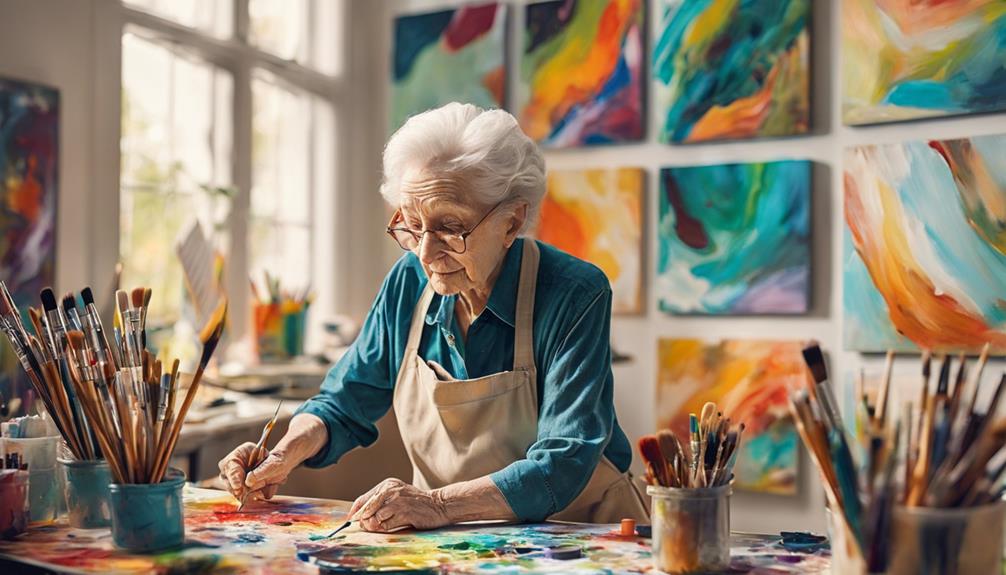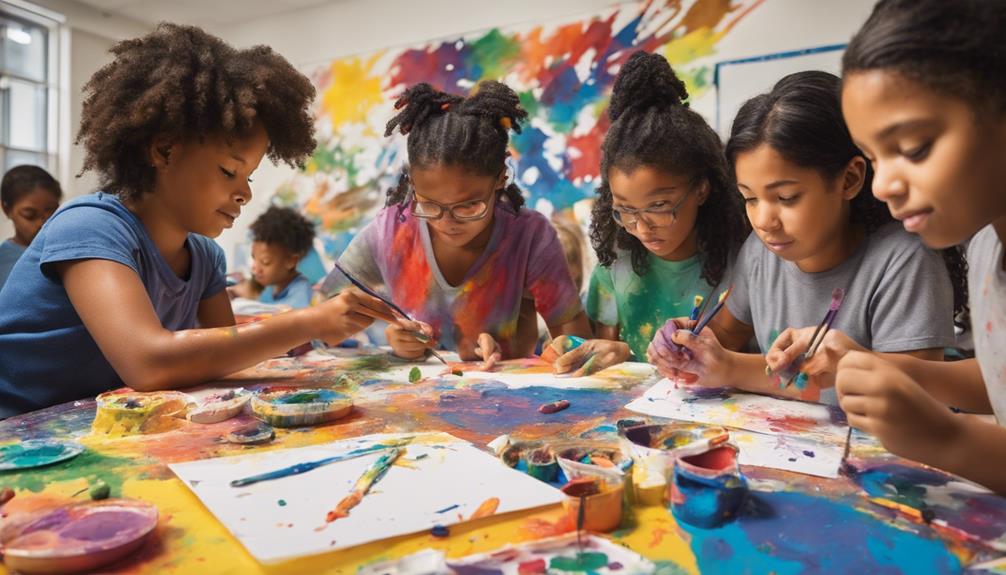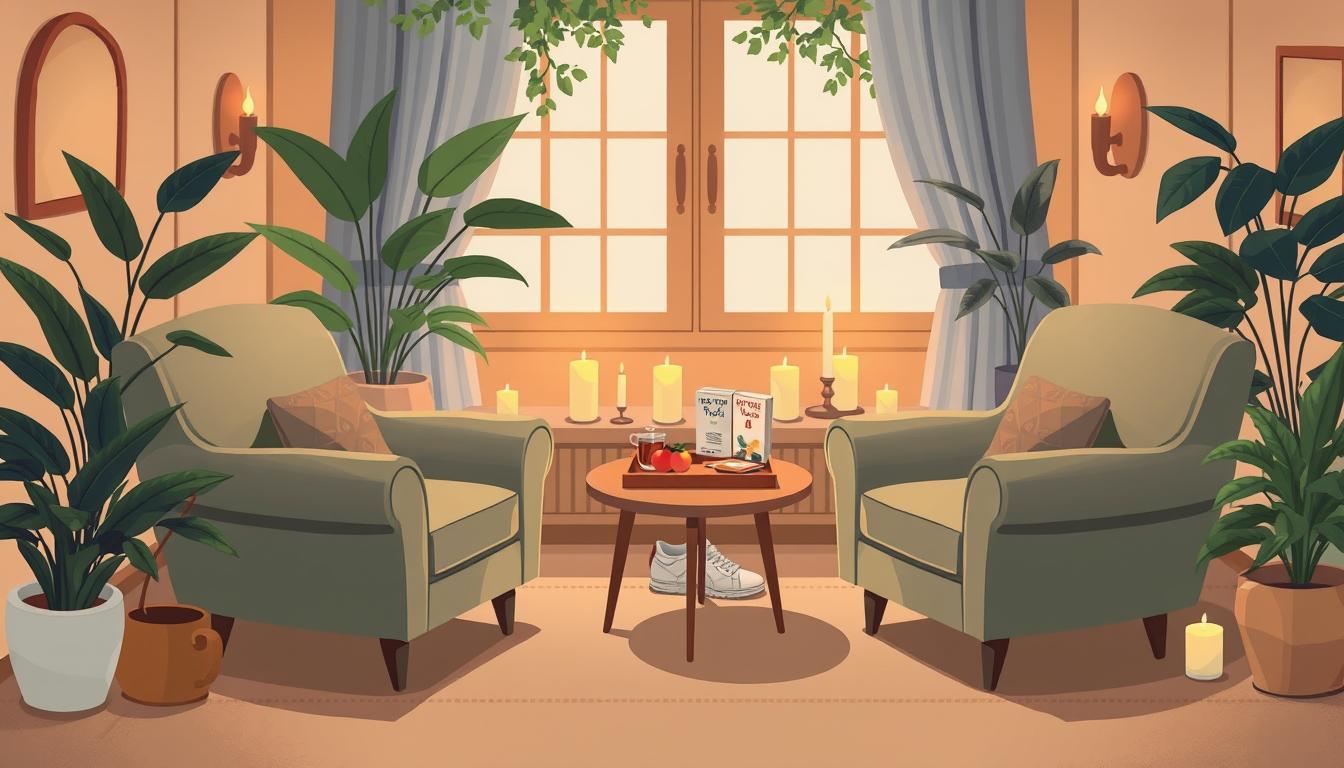Have you ever thought about the potential impact of including art lessons in our daily routines as we delve into the fascinating world of mental health and creative pursuits?
The link between engaging in creative activities and fending off memory problems among older adults is a topic worth contemplating.
Let's delve into how art lessons could offer a promising avenue for nurturing cognitive function and potentially safeguarding against memory decline.
Key Takeaways
- Art lessons nurture creativity and safeguard memory function.
- Regular art activities reduce the likelihood of memory issues.
- Engaging in art lowers the risk of cognitive impairment.
- Art therapy techniques forge new neural connections for memory enhancement.
Benefits of Engaging in Art Lessons
Engaging in art lessons offers a transformative journey that not only nurtures creativity but also serves as a powerful tool in safeguarding memory function as we age. Art therapy and engaging in crafts activities have been linked to a reduced risk of cognitive decline in older adults. Studies have shown that participation in art activities such as painting, drawing, woodworking, quilting, and sewing can help delay the development of memory problems, including dementia.
Creative arts, including these crafts activities, have been found to have a significant impact on cognitive health, with individuals who regularly partake in these activities experiencing a lower likelihood of memory issues. By immersing ourselves in the world of art, we not only express our creativity but also potentially protect our cognitive abilities as we grow older. This journey through art can be a fulfilling way to stimulate our minds and enhance our overall well-being.
Impact of Art on Memory Function

Exploring the profound relationship between art and memory function reveals a captivating journey through the realms of creativity and cognitive preservation. Engaging in art, such as painting or woodworking, can play a crucial role in reducing the risk of memory problems, including cognitive impairment in old age. A study focusing on individuals aged 85-89 discovered that participation in arts and crafts significantly decreased the likelihood of developing mild cognitive impairment. Men and women who practiced crafts like quilting and sewing were found to have a 45% lower risk of memory issues. Additionally, social activities have been shown to lower the risk by 55%, highlighting the importance of social engagement in memory health. Furthermore, computer use, particularly activities like Internet searches, was linked to a 53% decrease in the risk of mild cognitive impairment. Art, whether through creative expression or engaging in social activities, can be a powerful tool in preserving memory function and reducing the risk of conditions like Alzheimer's disease.
| Art Activities | Impact on Memory Function |
|---|---|
| Painting | Reduces risk of memory issues |
| Woodworking | Helps ward off cognitive impairment |
| Quilting & Sewing | 45% lower likelihood of memory problems |
| Social Activities | 55% lower risk of memory issues |
Connection Between Art and Cognitive Health
Artistic endeavors, such as painting and woodworking, offer a gateway to enhancing cognitive health and fostering memory resilience in individuals of all ages. Engaging in artistic activities not only stimulates creativity but also plays a crucial role in maintaining cognitive functions. For older adults, participating in art projects can significantly lower the risk of memory problems and mild cognitive impairment. The act of creating art provides a mental workout that can help preserve memory and cognitive abilities over time.
Moreover, the social aspect of artistic endeavors further contributes to cognitive health. Studies show that social engagement can reduce the likelihood of memory issues by 55%, emphasizing the importance of interaction in maintaining cognitive functions. Additionally, activities like computer use, such as browsing the internet, have been linked to a 53% lower risk of mild cognitive impairment, highlighting the various ways in which technology and art can positively impact cognitive health. Embracing artistic activities not only enriches life but also serves as a form of memory care, potentially warding off conditions like dementia.
Strategies for Implementing Art Lesson Plans

Connecting seniors with the joy of artistic expression through carefully crafted lesson plans is a pivotal step towards enhancing cognitive health and memory retention. When implementing art lesson plans for older adults, it's essential to offer a diverse range of activities such as painting, drawing, sculpting, woodworking, ceramics, quilting, and sewing. By providing a variety of artistic outlets, seniors can engage in activities that cater to different interests and skill levels, ensuring a more inclusive experience.
Incorporating social engagement into art projects is key to reducing the risk of memory problems in seniors. Encouraging group activities where individuals can interact, share ideas, and collaborate on creative endeavors not only fosters a sense of community but also stimulates cognitive function. Moreover, utilizing computer technology for activities like online shopping and internet searches can further lower the likelihood of mild cognitive impairment, offering seniors a chance to stay technologically savvy while enhancing their mental acuity through artistic expression.
Art Therapy Techniques for Memory Enhancement
Enhancing memory through art therapy techniques involves harnessing the power of creative expression to forge new neural connections in the brain, supporting cognitive function and memory retention. Engaging in art activities like painting and drawing stimulates these neural connections, aiding in memory enhancement. Art therapy focuses on using creative expression to trigger positive memories and emotions, which can be particularly beneficial for individuals facing memory problems. By creating new connections in the brain through artistic endeavors, individuals can bolster their cognitive abilities and improve memory retention.
Studies have shown that art therapy is an effective tool in enhancing memory and cognitive function. Through the process of creating art, individuals can tap into different parts of their brain, fostering a holistic approach to memory enhancement. By incorporating art therapy techniques into memory improvement strategies, individuals can't only stimulate their minds but also enjoy the therapeutic benefits of creative expression.
Frequently Asked Questions
How Does Art Help With Memory Loss?
Art helps with memory loss by stimulating the brain through creative expression. Engaging in art activities like painting and crafting forms new connections in the brain, reducing the risk of memory problems. Art projects strengthen cognitive functioning and can even prevent Alzheimer's disease.
Through artistic expression, individuals can communicate and express themselves, fostering positive emotions and triggering new memories. Art therapy provides a non-verbal outlet for those with memory loss to connect and engage with the world.
Does Making Art Prevent Dementia?
Making art can be a powerful tool in preventing dementia. Engaging in artistic activities like painting, drawing, and woodworking can lower the risk of developing mild cognitive impairment.
Studies have shown a significant decrease in memory problems for individuals who participate in arts and crafts. Additionally, creating art fosters cognitive stimulation and social engagement, both essential components in maintaining brain health and potentially warding off dementia.
How to Prevent Memory Loss?
To prevent memory loss, we prioritize engaging in activities that challenge our minds, such as learning new skills, puzzles, and physical exercise.
Additionally, maintaining social connections and staying mentally active through hobbies like painting, drawing, or crafts can also help stave off cognitive decline.
How Do You Help Someone With Poor Memory?
When someone struggles with poor memory, we can offer support through various means. Encouraging daily routines, like consistent sleep and exercise, can help.
Creating memory aids, such as notes or reminders, is beneficial. Engaging in social activities and conversations can also stimulate memory.
Additionally, incorporating puzzles and games into their routine can be fun and helpful. By combining these strategies, we can provide holistic support for those facing memory challenges.
Conclusion
In the palette of life, art lesson plans add vibrant colors to our memories, painting a picture of cognitive vitality and creativity. Like skilled artists, we brush away the dust of forgetfulness with each stroke of a paintbrush or twist of a clay mold.
Let's continue to sculpt our minds with the beauty of art, preserving our memories like precious masterpieces on the canvas of our lives.









